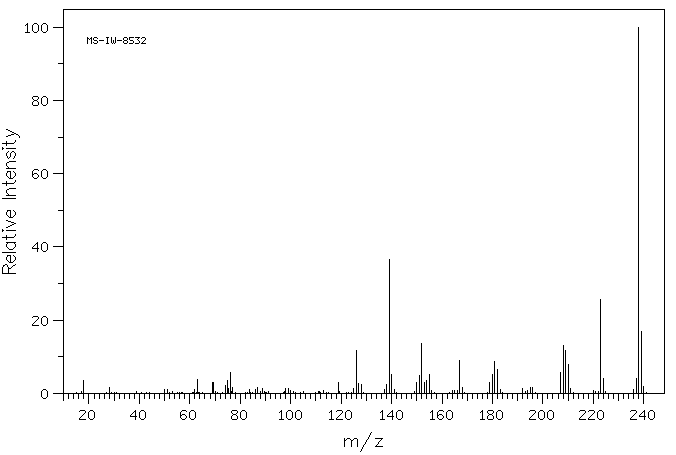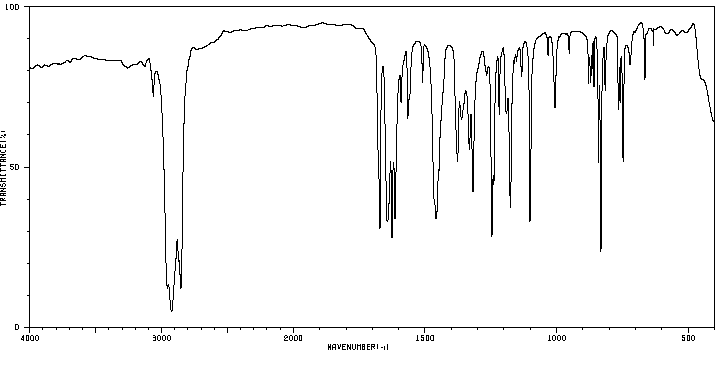annoquinone-A | 30684-16-3
中文名称
——
中文别名
——
英文名称
annoquinone-A
英文别名
3-methoxy-phenanthrene-1,4-dione;3-Methoxy-phenanthren-1,4-dion;3-Methoxyphenanthren-1,4-chinon;Annoquinone A;3-methoxyphenanthrene-1,4-dione
CAS
30684-16-3
化学式
C15H10O3
mdl
——
分子量
238.243
InChiKey
BTIQIBXDCYXMBX-UHFFFAOYSA-N
BEILSTEIN
——
EINECS
——
-
物化性质
-
计算性质
-
ADMET
-
安全信息
-
SDS
-
制备方法与用途
-
上下游信息
-
文献信息
-
表征谱图
-
同类化合物
-
相关功能分类
-
相关结构分类
计算性质
-
辛醇/水分配系数(LogP):2.6
-
重原子数:18
-
可旋转键数:1
-
环数:3.0
-
sp3杂化的碳原子比例:0.07
-
拓扑面积:43.4
-
氢给体数:0
-
氢受体数:3
上下游信息
-
下游产品
中文名称 英文名称 CAS号 化学式 分子量 —— 2-Bromo-3-methoxyphenanthrene-1,4-dione 90020-53-4 C15H9BrO3 317.13
反应信息
-
作为反应物:描述:参考文献:名称:Lora-Tamayo et al., Anales de la Real Sociedad Espanola de Fisica y Quimica, 1957, vol. 53, p. 63,68摘要:DOI:
-
作为产物:描述:5-溴香兰素 在 ammonium peroxydisulfate 、 iron(III) chloride hexahydrate 、 双氧水 、 palladium diacetate 、 sodium carbonate 、 potassium carbonate 、 三苯基膦 作用下, 以 四氢呋喃 、 甲醇 、 水 、 甲苯 、 乙腈 为溶剂, 反应 29.5h, 生成 annoquinone-A 、参考文献:名称:评估合成的丹参酮I和异丹参酮I类似物在斑马鱼中的抗炎作用。摘要:在炎症过程中,嗜中性粒细胞行为失调可能在一系列慢性炎症疾病中起主要作用,对于这些疾病,许多目前的治疗方法通常无效。最近,通过在体内靶向嗜中性粒细胞,特定的天然丹参酮已显示出令人鼓舞的抗炎作用,然而,就合成和生物学效应而言,此类丹参酮以及其异构体异丹参酮对应物在很大程度上仍未得到充分开发。为了探索异丹参酮和更广泛的丹参酮的抗炎作用,合成了一系列取代的丹参酮和异丹参酮类似物,以及其他结构相似的分子。使用嗜中性炎症的转基因斑马鱼模型对这些化合物的评估显示了体内不同的抗炎特性,许多化合物显示出令人鼓舞的效果。几种化合物减少嗜中性白细胞的初始募集和/或促进嗜中性白细胞炎症的消退,其中两种还导致人嗜中性白细胞的凋亡增加。特别是,甲氧基取代的丹参酮39可以在不影响嗜中性粒细胞募集到炎症部位的情况下,特别地加速炎症的消退,这使其成为潜在的促分辨率治疗剂特别有吸引力的候选物,以及功能化丹参酮的未来开发的潜在DOI:10.1371/journal.pone.0240231
文献信息
-
Some results obtained in the utilisation of quinones as philodiene作者:M. Lora-TamayoDOI:10.1016/0040-4020(58)88002-3日期:1958.1In the course of a study of new applications of the Diels-Alder reaction, the addition of p-benzoquinone and substituted quinones to ethylene-aromatic dienes and heteroconjugations containing nitrogen, has been investigated.在的Diels-Alder反应的新应用的研究的过程中,的添加p苯醌和取代的苯醌为乙烯芳族二烯和含氮heteroconjugations,进行了研究。
-
Facile construction of 3-hydroxyphenanthrene-1,4-diones: key intermediates to tanshinone I and its A-ring-modified analogue作者:Mingkun Jiao、Chunyong Ding、Ao ZhangDOI:10.1016/j.tet.2014.03.019日期:2014.5key precursor for total synthesis of tanshinone I. This tandem process includes decarboxylative radical alkylation, intramolecular C–H arylation and one-pot O-demethylation and aromatization. Variously substituted phenylpropanoic acids were well tolerated in this approach, and synthesis of tanshinone I (1) was finally successful in six straight steps in 19% overall yields from commercially available
-
Annoquinone-A, an antimicrobial and cytotoxic principle from Annona montana作者:Tian-Shung Wu、Ting-Ting Jong、Hsien-Ju Tien、Chang-Sheng Kuoh、Hiroshi Furukawa、Kuo-Hsiung LeeDOI:10.1016/s0031-9422(00)82257-8日期:1987.1new naturally occurring phenanthrene-1,4-quinone, annoquinone-A, along with parietin (physcion) and β-sitostenone were isolated from the stem bark of Annona montana . The structure of annoquinone-A was elucidated by spectral methods and synthesis. Annoquinone-A demonstrated potent antimicrobial activity against Bacillus subtilis and Micrococcus luteus as well as cytotoxicity in the KB ( ED 50 = 0.16
-
Lora-Tamayo et al., Anales de la Real Sociedad Espanola de Fisica y Quimica, Serie B: Quimica, 1957, vol. 53, p. 63,66作者:Lora-Tamayo et al.DOI:——日期:——
-
Mentally disordered parricide and stranger killers admitted to high-security care. 1: A descriptive comparison作者:Helen Baxter、Conor Duggan、Emmet Larkin、Christopher Cordess、Kim PageDOI:10.1080/09585180122057日期:2001.1Parricide is an uncommon crime, so that many of the descriptive studies suffer from methodological shortcomings of small sample sizes and a non-representative ascertainment. We describe a consecutive series of mentally disordered offenders convicted of parricide who were admitted to high-security care and we compare their index characteristics with a group convicted of killing one or more strangers. The main findings were that the parricides were more likely to suffer from schizophrenia but less likely to have had a disrupted childhood and criminal history, as compared with those who had killed a stranger. Those in the parricide group had made a previous attack on their victim in 40% of cases. Overall, the study confirmed some of the differences that one might expect between these two groups of homicides, which had entirely different relationships to their victims.
表征谱图
-
氢谱1HNMR
-
质谱MS
-
碳谱13CNMR
-
红外IR
-
拉曼Raman
-
峰位数据
-
峰位匹配
-
表征信息
同类化合物
(R)-2,2'',3,3''-四氢-6,6''-二-9-菲基-1,1''-螺双[1H-茚]-7,7''-二醇
(6,6)-苯基-C61己酸甲酯
高雌二醇
马兜铃酸钠
马兜铃酸盐
马兜铃酸C
马兜铃酸B
马兜铃酸(1:1MIXTUREOFARISTOLOCHICACIDIANDARISTOLOCHICACIDII)
马兜铃酸 Ia
马兜铃酸 IVa
马兜铃酸
颜料黑32
颜料红179
颜料红178
颜料红149
颜料红123
顺式-菲-1,2-二醇-3,4-环氧化物
顺式-苯并(a)屈-11,12-二醇-13,14-环氧化物
雷公藤酚A
镁二(1,4,5,6,7,16,17,18,19,19,20,20-十二氯六环[14.2.1.14,7.02,15.03,8.09,14]二十-5,9,11,13,17-五烯-11-磺酸酯)
钩大青酮
钩大青酮
钙(2+)12-羟基十八烷酸酯
酒石酸布托诺啡
那布扶林
还原红32
足球烯
贝那他汀B
贝母兰素
萘并[2,3-b]荧蒽
萘并[2,1-e][1]苯并二硫杂环戊烷
萘并[2,1-C:7,8-C']二菲
萘并[1,2-e][2]苯并呋喃-1,3-二酮
萘并[1,2-b]屈
萘并[1,2-a]蒽
萘并[1,2-B]菲-6-醇
萘二(六氯环戊二烯)加合物
萘,8-溴-1,2,3-三(1,1-二甲基乙基)-6-甲基-
菲醌单缩氨基硫脲
菲醌
菲并[9,10]呋喃
菲并[9,10-e]醋菲烯
菲并[4,5-bcd]噻吩
菲并[4,5-bcd]呋喃-3-醇
菲并[4,3-d]-1,3-二噁唑-5-羧酸,10-羟基-9-甲氧基-6-硝基-
菲并[3,2-b]噻吩
菲并[2,1-d]噻唑
菲并[2'',1'',10'':4,5,6;7'',8'',9'':4',5',6']二异喹啉并[2,1-a:2',1'-a']二萘嵌间二氮杂苯-8,13-二酮
菲并(3,4-b)噻吩
菲并(1,2-b)噻吩








